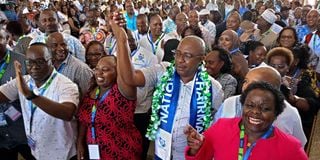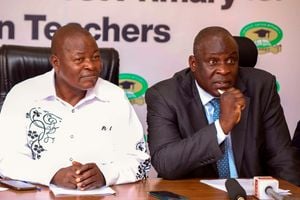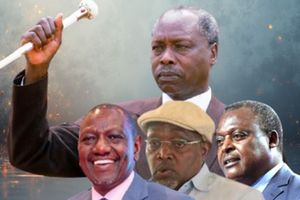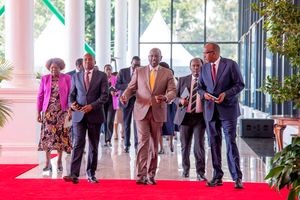
Murang’a High School Principal Willy Kuria celebrates after being elected Kenya Secondary Schools Heads Association chairman at Sheikh Khalifa Bin Zayed Hall in Mombasa on June 24, 2024.
Principals have asked the Ministry of Education to split Junior Secondary School learners between primary and secondary schools.
Junior Secondary School, which was introduced under the Competency Based Curriculum (CBC) last year, consists of learners from Grade 7, Grade 8 and Grade 9. The new structure got off to a rocky start in primary schools.
And now principals want learners from Grade 8 and Grade 9 to move to secondary schools.
The principals spoke yesterday during the Kenya Secondary Schools Heads Association (Kessha) annual conference in Mombasa County.
The head teachers said that secondary schools have existing infrastructure such as laboratories, unlike primary schools.
Principals are worried about the lack of preparedness in primary schools and urged the State to allow the learners to transit to secondary schools.
Critical infrastructure
“We are far better than primary schools. We have classrooms, laboratories, teachers, and other critical infrastructure. We are not as badly off as primary schools,” Kessha national chairperson Willy Kuria said.
He said under the current arrangement, learners will remain in primary schools for 11 years; from pre-primary, primary and junior school, and only spend three years in senior school.
Under the original Basic Education Curriculum Framework, junior school was supposed to be placed in secondary schools.
But the government reversed the decision following recommendations by the Presidential Working Party on Education Reforms.
“Will the child be moulded in those three years ready for university? Where are the facilities to keep a child in primary school for 11 years... which is a lesser evil?” Asked Mr Kuria.
“There will be no Form One class next year, so the existing infrastructure including laboratories and classrooms will be idle. The classrooms can accommodate the Grade 9 learners. As far as infrastructure is concerned, we have adequate space and staff,” he said.
The Murang’a High School principal said his school has 12 Form One classrooms that will be unused next year once the students transit to Form 2.
He said unutilised classrooms in secondary schools should be used by junior school learners instead of the government planning to build extra classrooms in primary schools.
Sabunley Secondary School Principal Abdi Noor, who is also a Kessha official, said the age of learners should not be a determinant for placing junior secondary learners in primary schools.
Selection of learner for entry into senior school will be based on learners' abilities, interests, and career choices. Learners will choose between social sciences, arts and sports, and science technology, engineering and mathematics (STEM).
Each pathway will offer a unique set of subjects and learning experiences that align with specific career paths.
The 42-member Presidential Working Party on Education Reforms chaired by Prof Raphael Munavu was appointed in 2022 and engaged parents, teachers, religious leaders, school owners and other crucial education stakeholders before coming up with the recommendations.
Education Cabinet Secretary Ezekiel Machogu has emphasis the Grade 9 will be placed in primary schools, even as the State races against time to put up more infrastructure for learners.
Pull and push
There has been a lot of pull and push among stakeholders on where the Grade 9 learners should be placed.
“When the Presidential Working Party on Education Reforms was taking views from the stakeholders, we stated that the learners should remain in primary school for seven years. But once they sit their Kenya Primary School Education Assessment (KPSEA), they transit to secondary school where they continue with CBC because they had been introduced to it while in Grade 7,” said Mr Kuria.
The Kessha position has previously been supported by the Kenya Union of Post-Primary Education Teachers, which represents teachers in secondary schools.
However, in an interview with the Nation, the Kenya National Union of Teachers Secretary-General Collins Oyuu said junior secondary teachers lack the requisite skills to teach learners. He said Knut is working on a policy paper to determine who should stay in junior secondary.
He urged the Ministry of Education and the Teachers Service Commission to deliberate on JS










